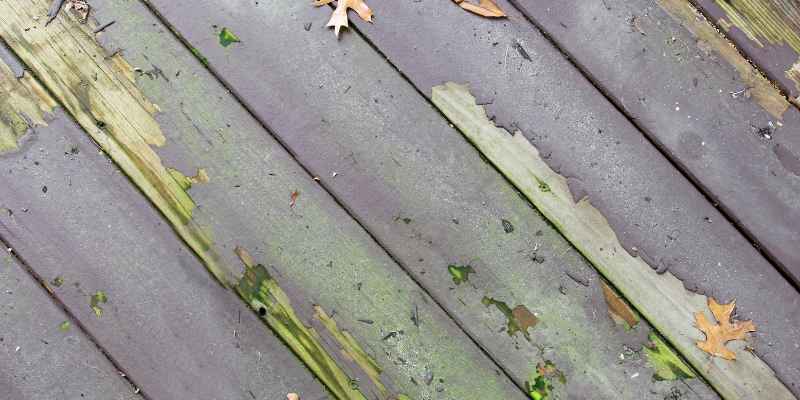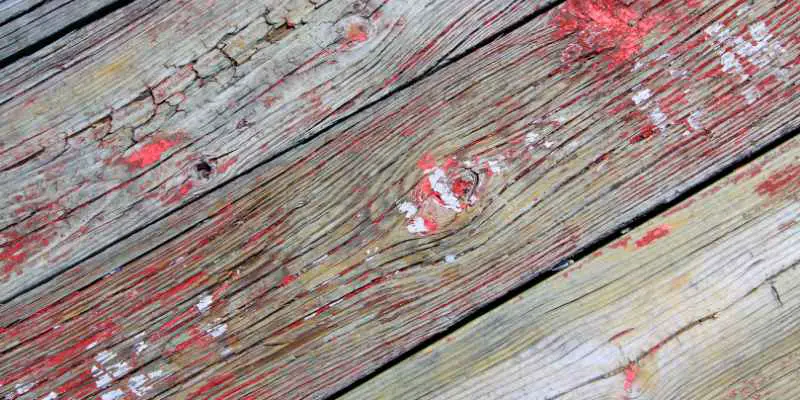To paint a deck with peeling paint, first, you need to remove the old paint using a scraper or sander, then clean the surface thoroughly before applying a fresh coat of paint. The peeling paint on a deck not only affects its appearance but also its durability and lifespan.
By following the right steps and using the correct materials, you can restore your deck’s beauty and protect it from further damage. This article will guide you through the process of painting a deck with peeling paint, providing you with all the essential information and tips to get the job done efficiently.
So let’s dive in and transform your peeling deck into a vibrant outdoor space you can enjoy.
Assessing The Situation
Assessing the situation is crucial when it comes to painting a deck with peeling paint. Start by thoroughly examining the deck, identifying areas of peeling paint, and determining the cause. This will help you plan the necessary steps to prep and repaint the deck, ensuring a long-lasting and beautiful finish.
Assessing The Situation:
Before diving into the process of painting a deck with peeling paint, it is essential to assess the situation and understand the extent of the problem. This assessment will help you determine the necessary steps to take for a successful paint job and ensure your deck looks beautiful and well-maintained.
Identify The Problem Areas:
To begin with, identify the problem areas on your deck where the paint is peeling. These areas may include sections where the paint is blistering, cracking, or flaking away. Take note of these spots as they will require special attention during the painting process.
Determine The Cause Of Peeling Paint:
To effectively address the peeling paint on your deck, it’s important to determine the cause behind it. Peeling paint can occur due to various reasons, such as:
- Inadequate surface preparation: If the deck was not properly cleaned, sanded, or primed before painting, the paint may not adhere properly and start peeling over time.
- Moisture and water damage: Exposure to moisture, whether from rain, snow, or humidity, can lead to paint peeling. Water seeping into the wood can cause it to swell and push the paint off.
- UV damage: Continuous exposure to sunlight can cause the paint to fade, deteriorate, and eventually peel.
- Age and wear: With time, paint on a deck may naturally start to peel due to regular foot traffic, furniture movement, or other factors that cause wear and tear.
By understanding the underlying cause, you can address the root issue and take appropriate measures to prevent further peeling in the future.

Preparing The Deck
If you have a deck that’s showing signs of peeling paint, it’s time to roll up your sleeves and give it a fresh new look. Preparing the deck is the crucial first step in ensuring that your paint job lasts and looks great. With the right approach, you can have a deck that’s ready to be transformed into a stunning outdoor space. Here’s how to prepare your deck for painting:
Clear The Deck
The first step in preparing your deck is to clear out any furniture, plants, or other objects that may obstruct your work. By creating a clutter-free workspace, you’ll have better access to the entire surface of the deck and ensure an even application of paint. Store away any items that can be easily removed or cover them with a tarp to protect them during the painting process.
Clean The Surface
Before you start painting, it’s essential to clean the deck’s surface thoroughly. Dirt, mildew, and other residues can interfere with the adhesion of the new paint and cause it to peel prematurely. To clean the deck effectively, use a pressure washer or a scrub brush and a gentle cleaning solution. Scrub the surface in the direction of the wood grain to avoid causing any damage. Rinse the deck thoroughly with clean water and allow it to dry completely before moving on to the next step.
Remove Any Loose Paint
To ensure a smooth and lasting paint job, it’s crucial to remove any loose or peeling paint from the deck’s surface. Use a scraper or a wire brush to gently scrape away the loose paint, being careful not to damage the wood beneath. It’s important to remove all loose paint as any remaining flakes may cause the new paint to peel. Once you’ve removed the loose paint, sand the surface lightly to create a smooth and even texture that will help the new paint adhere better.
By following these steps to prepare your deck, you’ll be on your way to a successfully painted surface that will withstand the elements and stay beautiful for years to come.
Repairing And Restoring
Easily revive your deck with peeling paint by following these simple steps to repaint and restore its beauty. Restore the luster of your outdoor space with a fresh coat of paint, giving your deck a new lease on life.
Is your deck suffering from peeling paint? Don’t worry, with a little bit of time and effort, you can bring it back to its former glory. In this section, we will guide you through the necessary steps to repair and restore your deck, starting with making necessary repairs.
Make Necessary Repairs
Before you begin painting, it’s important to address any underlying issues with your deck. First, inspect the deck for loose boards or nails that may pose a safety hazard. Secure any loose boards with screws and replace any damaged boards as needed. Additionally, check for any signs of rot or decay. If you find any, be sure to remove and replace the affected boards.
Sand The Deck
To ensure a smooth and even surface for the new paint, it’s essential to sand the deck. Start by using a coarse-grit sandpaper to remove the remaining peeling paint and any rough spots. Then, switch to a finer-grit sandpaper to achieve a smooth finish. Sanding not only promotes better adhesion of the new paint but also helps to remove any stains or discoloration.
Apply A Primer
Now that you have made the necessary repairs and sanded the deck, it’s time to apply a primer. A primer helps to create a strong bond between the wood and the paint, ensuring better durability and longevity. Choose a high-quality primer suitable for outdoor use. Using a paintbrush or roller, apply an even coat of primer to the entire deck surface, following the manufacturer’s instructions for drying time.
Apply New Paint
Finally, it’s time to apply the new paint to your deck. Be sure to choose a paint specifically designed for exterior use, as it will be more resistant to weathering and UV rays. Using a paintbrush or roller, apply a thin and even coat of paint, working in small sections. Pay extra attention to any areas prone to heavy foot traffic or direct sunlight exposure. Allow the first coat to dry thoroughly before applying a second coat for added protection.
By following these simple steps of making necessary repairs, sanding the deck, applying a primer, and applying new paint, you can transform your deck from peeling and worn-out to a beautiful and rejuvenated outdoor space. Now take out your tools and get ready to give your deck the attention it deserves!
Need assistance with deck repair? Contact our expert team today for professional advice and services.
Maintaining The Deck
To transform a deck with peeling paint, start by thoroughly cleaning the surface to remove loose flakes. Next, sand the deck and apply a primer before adding fresh paint. Regular maintenance will ensure your deck looks beautiful and lasts longer.
Regular cleaning:
To keep your deck looking its best and prevent peeling paint, regular cleaning is crucial. Lightly sweep the deck surface to remove any loose dirt or debris. Then, mix a solution of warm water and mild detergent and use a scrub brush or power washer to clean the deck thoroughly. Rinse the deck with water afterwards to ensure all the soap residue is removed. This simple cleaning routine will help remove any mold, mildew, or other contaminants that can contribute to peeling paint.
Periodic inspections:
In addition to regular cleaning, it’s important to conduct periodic inspections of your deck to identify any areas where the paint may be peeling or chipping. Taking the time to inspect your deck allows you to catch any potential issues early on and prevent them from becoming more significant problems. Use a scraper or putty knife to gently remove any loose or peeling paint, taking care not to damage the underlying wood surface. Once any loose paint has been removed, you can then proceed with the necessary repairs and touch-ups.
Applying a protective finish:
Applying a protective finish to your deck is essential for long-term maintenance and preventing future paint peeling. Choose a high-quality deck stain or paint specifically formulated for outdoor use. Before applying the finish, ensure the deck is completely dry and free of any dust or debris. Use smooth, even strokes to apply the finish, following the manufacturer’s instructions for drying time between coats. A protective finish not only enhances the appearance of your deck but also acts as a barrier against UV rays, moisture, and other elements that can cause paint to peel.
Remember, maintaining your deck is an ongoing process. Regularly cleaning and inspecting the deck, as well as applying a protective finish, will help extend its lifespan and keep it looking beautiful for years to come. By investing a little time and effort into proper maintenance, you can enjoy your deck without worrying about peeling paint or other issues.
Expert Tips And Tricks
If your deck has peeling paint, it’s time to give it a fresh coat of paint and bring it back to life. With the right knowledge and techniques, painting a deck with peeling paint can be a straightforward and rewarding project. In this section, we’ll share some expert tips and tricks to help you get the job done efficiently and effectively.
Choosing The Right Paint
- Inspect your deck: Carefully examine your deck to determine the type of paint that is currently peeling. This will help you choose the appropriate paint for your project.
- Opt for durable paint: Look for exterior-grade latex or oil-based paint that is specifically designed for decks. These paints are more resistant to peeling and can withstand weather elements.
- Consider the finish: Decide whether you prefer a glossy or matte finish. Glossy finishes are more durable and easier to clean, while matte finishes give a natural and rustic look.
Optimal Weather Conditions
- Dry and mild weather: Choose a day when the weather is dry and mild. Avoid painting your deck on extremely hot or cold days as it can affect the paint’s ability to adhere properly.
- Avoid direct sunlight: Plan your painting project for a time when your deck is in shade or avoid direct sunlight. This will prevent the paint from drying too quickly and causing uneven application.
- Avoid rain or high humidity: Moisture can ruin your paint job, so make sure the weather forecast shows no rain or high humidity for at least 48 hours.
Proper Tools And Techniques
- Prepare the surface: Start by scraping off the peeling paint and sanding the surface to create a smooth and even base for the new paint.
- Clean the deck: Remove any dirt, debris, and mildew from the deck using a pressure washer or a solution of mild soap and water.
- Use a primer: Applying a primer before painting can improve adhesion and ensure a longer-lasting finish. Choose a primer that is compatible with the type of paint you have selected.
- Apply the paint: Use a brush or a roller to apply the paint evenly across the deck. Start from one end and work your way towards the other, following the wood grain.
- Allow proper drying time: Give the freshly painted deck enough time to dry completely before walking on it or placing any furniture. This will help prevent smudges and marks.

Conclusion
When it comes to painting a deck with peeling paint, following these steps will help you achieve a fresh and long-lasting finish. Start by thoroughly cleaning and sanding the surface, then apply a high-quality primer and finish with a durable paint.
Regular maintenance and proper care will protect your deck from further peeling and maintain its beauty for years to come. Don’t forget to check out our detailed guide for more tips and tricks on painting your deck. Happy painting!

